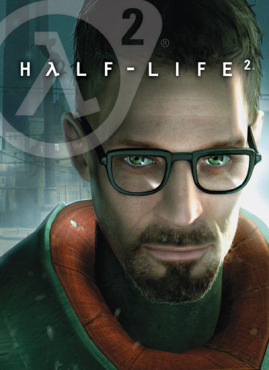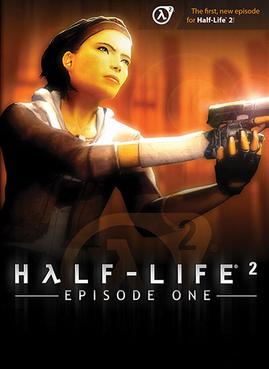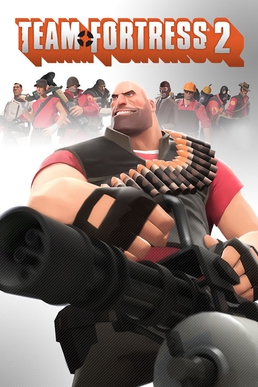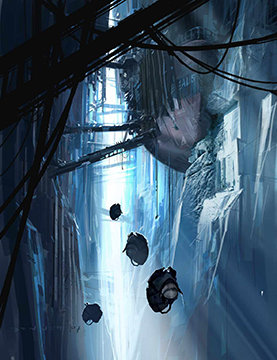
Valve Corporation, also known as Valve Software, is an American video game developer, publisher, and digital distribution company headquartered in Bellevue, Washington. It is the developer of the software distribution platform Steam and the game franchises Half-Life, Counter-Strike, Portal, Day of Defeat, Team Fortress, Left 4 Dead, and Dota.

LightWave 3D is a 3D computer graphics program developed by LightWave Digital. It has been used in films, television, motion graphics, digital matte painting, visual effects, video game development, product design, architectural visualizations, virtual production, music videos, pre-visualizations and advertising.

Half-Life 2 is a 2004 first-person shooter (FPS) game developed and published by Valve Corporation. It was published for Windows on Valve's digital distribution service, Steam. Like the original Half-Life (1998), Half-Life 2 combines shooting, puzzles, and storytelling, and adds new features such as vehicles and physics-based gameplay. The player controls Gordon Freeman, who joins a resistance to liberate Earth from the Combine, an interplanetary alien empire.
Source is a 3D game engine developed by Valve. It debuted as the successor to GoldSrc in 2004 with the releases of Half-Life: Source, Counter-Strike: Source, and Half-Life 2. It is most well-known for its usage by Valve, but the engine has been used both by small teams and individuals to create modifications of Valve games, and other studios creating distinct games, notably Troika Games' title Vampire: The Masquerade – Bloodlines. Valve continued to create incremental updates to the Source engine after its 2004 release, most of which coincided with games created by Valve. In the late 2010s, Valve created the Source 2 engine to replace Source, with it publicly debuting alongside Half-Life: Alyx. The Source engine is most well-known for its advancements in physics, AI, and graphics.

Half-Life 2: Episode One is a 2006 first-person shooter game developed and published by Valve for Windows. It continues the story of Half-Life 2 (2004); as scientist Gordon Freeman, players must escape City 17 with Gordon's companion Alyx Vance. Like previous Half-Life games, Episode One combines shooting, puzzles and storytelling.

Team Fortress 2 (TF2) is a 2007 multiplayer first-person shooter game developed and published by Valve Corporation. It is the sequel to the 1996 Team Fortress mod for Quake and its 1999 remake, Team Fortress Classic. The game was released in October 2007 as part of The Orange Box for Windows and the Xbox 360, and ported to the PlayStation 3 in December 2007. It was released as a standalone game for Windows in April 2008, and updated to support Mac OS X in June 2010 and Linux in February 2013. It is distributed online through Valve's digital retailer Steam, with Electronic Arts managing retail and console editions.

Half-Life 2: Episode Three is a canceled first-person shooter game developed by Valve. It was planned as the last in a trilogy of episodic games continuing the story of Half-Life 2 (2004). Valve announced Episode Three in May 2006, with a release planned for 2007. Following the cliffhanger ending of Episode Two (2007), it was widely anticipated. Marc Laidlaw, the writer for the Half-Life series, said he intended Episode Three to end the Half-Life 2 story arc.

Half-Life is a series of first-person shooter (FPS) games created by Valve. The games combine shooting combat, puzzles and storytelling.
Bay Leaf Raitt is an American Artist, 3D Graphic Novelist, Animator and Video Game Devoper. He was the Creature Facial Lead for Gollum on the Lord of the Rings movie Trilogy and Worked at Valve Software for 9 years before Founding the Spiraloid Workshop Company and Joining Unity3d. Previously he has worked for Image Comics, providing computer-image coloring for Steve Oliff to use with "Spawn", "The Pitt", and "The Maxx". He later worked at Protozoa, providing 3D animation computer effects. In 1999 Raitt emigrated to New Zealand to work for Weta Digital. In that post he was responsible for creating the computer-generated face for Gollum in The Lord of the Rings. In video games, he is a modeler, animator, and level designer for the videogame Squeezils.

Garry's Mod is a 2006 sandbox game developed by Facepunch Studios and published by Valve. The base game mode of Garry's Mod has no set objectives and provides the player with a world in which to freely manipulate objects. Other game modes, notably Trouble in Terrorist Town and Prop Hunt, are created by other developers as mods and are installed separately, by means such as the Steam Workshop. Garry's Mod was created by Garry Newman as a mod for Valve's Source game engine and released in December 2004, before being expanded into a standalone release that was published by Valve in November 2006. Ports of the original Windows version for Mac OS X and Linux followed in September 2010 and June 2013, respectively. As of September 2021, Garry's Mod has sold more than 20 million copies. A successor, Sandbox, has been in development since 2015.
iClone is a real-time 3D animation and rendering software program. Real-time playback is enabled by using a 3D videogame engine for instant on-screen rendering.
Facepunch Studios Ltd is a British video game developer and publisher headquartered in Birmingham, England, founded in June 2004 and incorporated on 17 March 2009 by Garry Newman. The company is most known for its sandbox video game Garry's Mod and survival game Rust. Facepunch is currently developing s&box, which is regarded as a spiritual successor to Garry's Mod.

GoldSrc, sometimes called the Half-LifeEngine, is a proprietary game engine developed by Valve. At its core, GoldSrc is a heavily modified version of id Software's Quake engine. It made its debut in 1998 with Half-Life and powered future games developed by or with oversight from Valve, including Half-Life's expansions, Day of Defeat and games in the Counter-Strike series.
The Saxxy Awards was an annual worldwide competition for 3D-animated films, hosted by video game developer, Valve. The first competition was held in 2011 and included 20 competition categories. In 2012, the number of categories was limited to five, and the contestants are required to use Valve's Source Filmmaker software to create their animations.

Mixamo Inc. is a 3D computer graphics technology company. Based in San Francisco, the company develops and sells web-based services for 3D character animation. Mixamo's technologies use machine learning methods to automate the steps of the character animation process, including 3D modeling to rigging and 3D animation.

Source 2 is a video game engine developed by Valve. The engine was announced in 2015 as the successor to the original Source engine, with the first game to use it, Dota 2, being ported from Source that same year. Other Valve games, such as Artifact, Dota Underlords, Half-Life: Alyx, and Counter-Strike 2, have been produced with the engine.

The Lab is a virtual reality (VR) video game developed by Valve and released for Windows on April 5, 2016. It uses VR technology to showcase a series of play experiences accessed through a hub room. The game is set in the Portal universe and offers eight different game types that involve short demo experiences that use different aspects of the VR capabilities. Variety is also offered beyond the experiences themselves by the amount of interactability with objects in the environment that is included. During the 20th Annual D.I.C.E. Awards, the Academy of Interactive Arts & Sciences nominated The Lab for "Immersive Reality Game of the Year".
Based on Id Software's open stance towards game modifications, their Quake series became a popular subject for player mods beginning with Quake in 1996. Spurred by user-created hacked content on their previous games and the company's desire to encourage the hacker ethic, Id included dedicated modification tools into Quake, including the QuakeC programming language and a level editor. As a game that popularized online first-person shooter multiplayer, early games were team- and strategy-based and led to prominent mods like Team Fortress, whose developers were later hired by Valve to create a dedicated version for the company. Id's openness and modding tools led to a "Quake movie" community, which altered gameplay data to add camera angles in post-production, a practice that became known as machinima.

Half-Life: Alyx is a 2020 virtual reality (VR) first-person shooter game developed and published by Valve. It was released for Windows and Linux, with support for most PC-compatible VR headsets. Set five years before Half-Life 2 (2004), players control Alyx Vance on a mission to seize a superweapon belonging to the alien Combine. Like previous Half-Life games, Alyx incorporates combat, puzzles and exploration. Players use VR to interact with the environment and fight enemies, using "gravity gloves" to snatch objects from a distance, similarly to the gravity gun from Half-Life 2.

Sandbox is an upcoming sandbox game developed and published by Facepunch Studios. Regarded as a spiritual successor to Garry's Mod, the base game has no set objective, but instead provides players with a platform from which to develop and play different user-created gamemodes.













